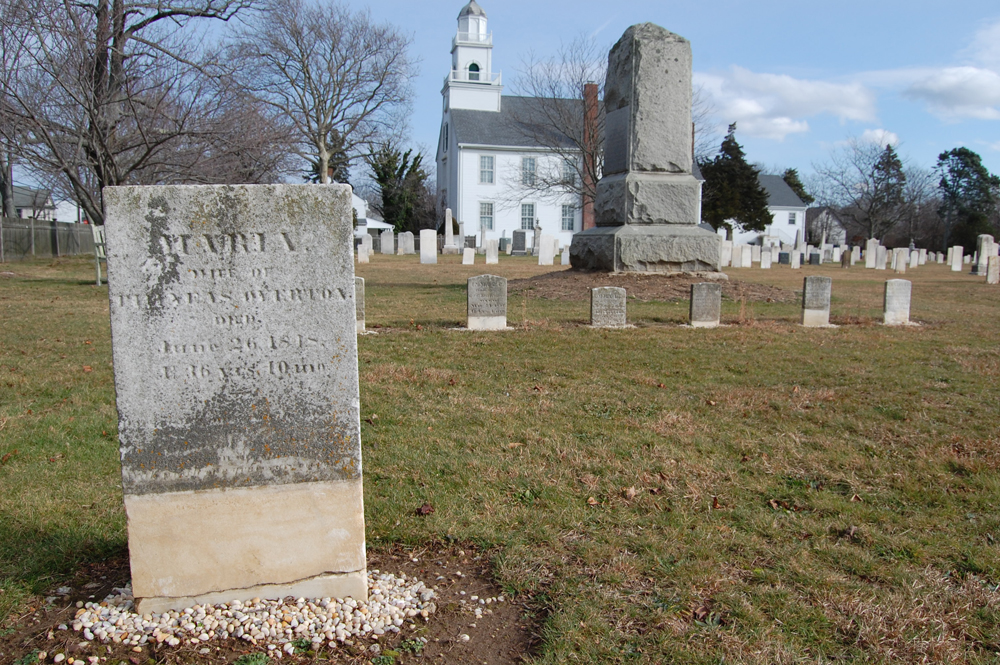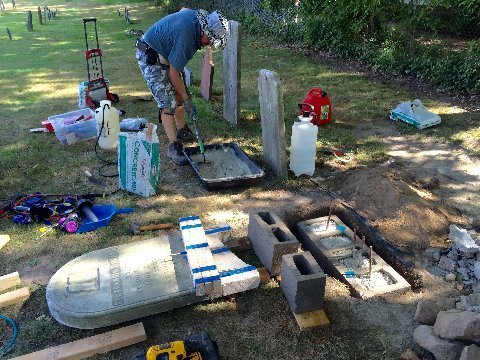Old Burying Ground raises $60,000 for gravestone repairs

Riddled with lichen, cracking near the base or leaning forward, the headstones at Southold’s Old Burying Ground were in a state of disrepair last spring.
Now — after close to $60,000 was raised to repair the burial markings — nearly half the stones slated for attention have been cleaned and 260 stones have had beds of pea gravel installed around their bases to prevent damage from lawn mowers. Another 192 stones have been straightened and about 50 markers made from sandstone now have temporary covers to protect them from the elements. A team of about 15 volunteers completed a majority of the work.
Cemetery director Jane Andrews said $30,000 was raised through a mail-in campaign, $22,750 came in the form of a grant from the Robert D. L. Gardiner Foundation and additional funds were raised at events to reach the final total.
“I never expected something like this to happen,” Ms. Andrews said of the financial and physical support the Southold cemetery received. “[In our grant application] I said we expected to raise $8,000 from the mail-in campaign.”
Ms. Andrews also hired Joel Snodgrass, an architectural conservator and expert in gravestone preservation, to make large repairs to stones in dire straits. Mr. Snodgrass has removed improper caulking from 36 stones and undertaken “difficult technical repairs” on around 65 markers, Ms. Andrews said.
Given the amount of work accomplished this year, Ms. Andrews believes the project may now take three to four years to complete instead of the originally anticipated five. Volunteers worked at the site alongside Mr. Snodgrass from June through early December. Work will resume around April when temperatures rise, Ms. Andrews said.
The Old Burying Ground is part of the larger cemetery owned by First Presbyterian Church and dates to the town’s founding in 1640. Today, the cemetery spans about eight acres and is still active for town residents who wish to be interred there.
Mr. Snodgrass said about one third of the stones mainly require cleaning, about a third need minimal repairs and the rest need extreme to severe repairs. These repairs range from removing a concrete base to replace it with a more permeable one, using pins to hold broken headstones together, lifting and resetting the 400-pound grave markers, filling cracks with caulk and more.
“It’s an example of someone’s previous good intentions, although unfortunately we now know that that’s not a wise and helpful thing,” Mr. Snodgrass said of damage inadvertently made to the stones by using vulnerable materials like brownstone or slate and basing grave markers in concrete.

“I try to never point criticism at the previous treatments because they’re always done with good intentions,” he said. “They’re normally done with the best technology and understanding at the time. But as time goes on, we learn what works and what doesn’t work.”
To keep track of the stones in question, which inhabit only one of the eight acres the cemetery sits on, Ms. Andrews devised a labeling system. Each stone has a white marker that identifies it in a numerical system. Then stones that have been cleaned have a red marker. Stones that need additional work, such as caulking or resetting, get a purple marker.
Last year, volunteers sprayed the stones with a chemical biocide that makes the algae, lichen and mold dissipate over time.
“That biological growth destroys the stone,” Ms. Andrews said. “The stone is soft and it works its way in and it makes it flake away. You have to be careful even touching the stones because if you touch it too hard the stone will come right off in your hand.”
The slate and brownstone grave markers are first lightly brushed with a soft brush to remove loose growths from the plaque. They are then sprayed with D2 , which works over time and continuously cleans the stones.
Ms. Andrews is already working to reapply for the Gardiner grant and is coming up with new ways to raise funds. Those interested in donating can write a check to The Old Burying Ground and mail it to the Presbyterian Church of Southold.
“How many places do you get the founding of the town laid out in stone?” she said of the OBG, as she refers to it. “This becomes an outdoor museum. The exhibits live in the open air. They’re not protected by a roof; they don’t have glass cases around them. They’re exposed, but just like the exhibits in a museum, they are telling us about our past.”








